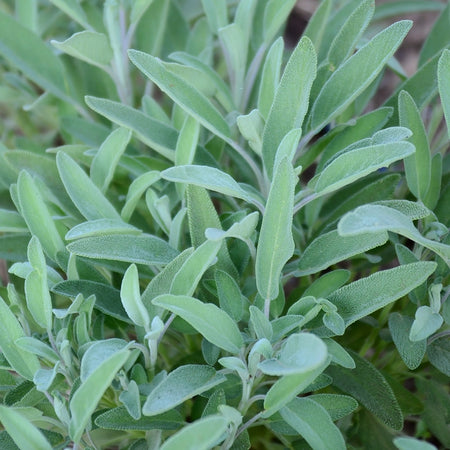1 g
Salvia officinalis “How can a man grow old who has sage in his garden?” is an ancient Chinese proverb. Sage with its lemony-camphor fragrance and delicate blue flowers is an important part of many fine recipes, medicinal remedies, and landscapes. Can grow to 2 feet. Hardy in zones 6-9. Approximately 150 seeds per gram. Germination code: (1)
Herbs feed the palate and the soul! They add color and contrast to the landscape, perfume our homes, heal our wounds, and tantalize our taste buds. They are easy to grow. Whether in the garden or on the windowsill, learn their likes and dislikes, and you'll be rewarded with flavor and beauty.
Germination Codes
Check the code at the end of the description for specific germination requirements.
(1) Germinates at temperatures between 60-75°F.
(2) Larger seeds need to be covered with soil at least as thick as the seed itself. May be slow and erratic to germinate.
(3) These seeds need a period of cold stratification for successful germination. Best results are obtained when the seeds are kept warm and moist for 2 weeks followed by temperatures of 33-35°F for 4-6 weeks or until germination starts.
(4) No special requirements, but germination may be slow and erratic.
Culture
• Fertile, well-drained soil provides the best results• Harvest and fertilize regularly to encourage vegetative growth
• Apply 1 cup of TSC's Complete fertilizer per 5 row feet, and 1 inch of compost
• For leafy herbs snip off flower buds as they appear
Transplanting
• Start seeds 6-8 weeks before anticipated transplant date
• Small seeds (thyme, savory, marjoram, oregano) can be gently pressed onto surface of the soil—don't cover or bury seed
• Fertilize with Age Old Grow every 10-14 days for optimum growth
• Small seedlings such as thyme, savory and sweet marjoram may be successfully transplanted in small clumps
• Hardy herbs can be transplanted after the last frost
• Transplant tender herbs after last frost when weather has stabilized
Harvest & Storage
• Fresh use: Harvest only as needed
• Drying: Harvest at peak maturity, hang small bunches from ceiling in a dry, warm (80-90°F), dark location with good ventilation for 1-2 weeks
• Distilling: Harvest when blooms are just beginning to appear; at this point the leaves contain the highest level of essential oils
Salvia officinalis “How can a man grow old who has sage in his garden?” is an ancient Chinese proverb. Sage with its lemony-camphor fragrance and delicate blue flowers is an important part of many fine recipes, medicinal remedies, and landscapes. Can grow to 2 feet. Hardy in zones 6-9. Approximately 150 seeds per gram. Germination code: (1)
Herbs feed the palate and the soul! They add color and contrast to the landscape, perfume our homes, heal our wounds, and tantalize our taste buds. They are easy to grow. Whether in the garden or on the windowsill, learn their likes and dislikes, and you'll be rewarded with flavor and beauty.
Germination Codes
Check the code at the end of the description for specific germination requirements.
(1) Germinates at temperatures between 60-75°F.
(2) Larger seeds need to be covered with soil at least as thick as the seed itself. May be slow and erratic to germinate.
(3) These seeds need a period of cold stratification for successful germination. Best results are obtained when the seeds are kept warm and moist for 2 weeks followed by temperatures of 33-35°F for 4-6 weeks or until germination starts.
(4) No special requirements, but germination may be slow and erratic.
Culture
• Fertile, well-drained soil provides the best results• Harvest and fertilize regularly to encourage vegetative growth
• Apply 1 cup of TSC's Complete fertilizer per 5 row feet, and 1 inch of compost
• For leafy herbs snip off flower buds as they appear
Transplanting
• Start seeds 6-8 weeks before anticipated transplant date
• Small seeds (thyme, savory, marjoram, oregano) can be gently pressed onto surface of the soil—don't cover or bury seed
• Fertilize with Age Old Grow every 10-14 days for optimum growth
• Small seedlings such as thyme, savory and sweet marjoram may be successfully transplanted in small clumps
• Hardy herbs can be transplanted after the last frost
• Transplant tender herbs after last frost when weather has stabilized
Harvest & Storage
• Fresh use: Harvest only as needed
• Drying: Harvest at peak maturity, hang small bunches from ceiling in a dry, warm (80-90°F), dark location with good ventilation for 1-2 weeks
• Distilling: Harvest when blooms are just beginning to appear; at this point the leaves contain the highest level of essential oils
